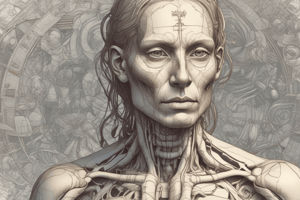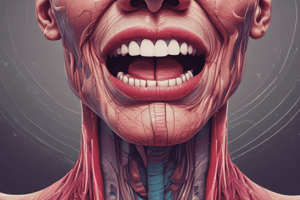Podcast
Questions and Answers
What is anatomy?
What is anatomy?
The science of the structure of the body.
Which plane divides the body into equal right halves?
Which plane divides the body into equal right halves?
- Transverse Plane
- Median Plane (correct)
- Coronal Plane
- Sagittal Plane
The dorsal refers to the front of the body.
The dorsal refers to the front of the body.
False (B)
Match the following anatomical terms with their definitions:
Match the following anatomical terms with their definitions:
What term describes the movement away from the midline of the body?
What term describes the movement away from the midline of the body?
What is the function of sebaceous glands?
What is the function of sebaceous glands?
The axial skeleton includes the bones of the limbs.
The axial skeleton includes the bones of the limbs.
Which type of joint allows for the most movement?
Which type of joint allows for the most movement?
What is the role of tendons?
What is the role of tendons?
Which type of cartilage is most commonly found at the ends of long bones?
Which type of cartilage is most commonly found at the ends of long bones?
The _____ is the outermost layer of skin.
The _____ is the outermost layer of skin.
What is the term for the place where a nerve enters a muscle?
What is the term for the place where a nerve enters a muscle?
What is a motor unit?
What is a motor unit?
What type of muscle is found inside many internal organs of the body?
What type of muscle is found inside many internal organs of the body?
What is peristalsis?
What is peristalsis?
What type of muscle is cardiac muscle?
What type of muscle is cardiac muscle?
What does the central nervous system (CNS) consist of?
What does the central nervous system (CNS) consist of?
What does the peripheral nervous system consist of?
What does the peripheral nervous system consist of?
What is the main function of neurons?
What is the main function of neurons?
What are the three protective membranes that surround the brain and spinal cord called?
What are the three protective membranes that surround the brain and spinal cord called?
What is the function of the dura mater?
What is the function of the dura mater?
Which nerves carry impulses toward the CNS?
Which nerves carry impulses toward the CNS?
What type of system is the autonomic nervous system?
What type of system is the autonomic nervous system?
What is the main function of lymphatic organs?
What is the main function of lymphatic organs?
The sympathetic nervous system prepares the body for 'rest and digest' activities.
The sympathetic nervous system prepares the body for 'rest and digest' activities.
Veins carry blood away from the heart.
Veins carry blood away from the heart.
What is the function of lacteals?
What is the function of lacteals?
Flashcards are hidden until you start studying
Study Notes
Introduction to Anatomy
- Anatomy is the scientific study of the body’s structure.
- Clinical anatomy focuses on macroscopic structures observable in the body.
Anatomical Planes
- Anatomical position serves as a standard reference for body descriptions.
- Median plane divides the body into equal right and left halves.
- Sagittal plane runs parallel to the median plane.
- Coronal (frontal) plane is perpendicular to the median plane.
- Horizontal plane lies perpendicular to the median and coronal planes.
- Transverse plane provides cross-sectional views of the body.
Directional Terms
- Anterior (ventral) refers to the front of the body.
- Dorsal (posterior) indicates the back of the body.
- Proximal means closer to the point of attachment; distal means further away.
- Superficial refers to being closer to the body surface, while deep means farther from it.
- Internal implies inside body structures, while external indicates outside.
- Ipsilateral describes being on the same side; contralateral means on the opposite side.
Body Positions
- Supine position is lying on the back; prone position is lying face down.
Movement Terms
- Afferent indicates movement towards a reference point; efferent indicates movement away.
- Flexion decreases joint angle; extension increases joint angle.
- Dorsiflexion elevates the foot; plantar flexion bends the foot down.
- Abduction moves away from the midline; adduction moves toward it.
- Inversion turns the foot's sole inward; eversion turns it outward.
- Rotation occurs around a long axis; medial rotation brings parts closer to the midline; lateral rotation moves them away.
- Circumduction is a circular movement of the limb's far end.
Skin and Hair Structure
- Epidermis is the outermost skin layer; dermis is beneath it, containing deeper structures.
- Nails are protective keratinized plates at the tips of fingers and toes; nail root is the proximal edge.
- Hair follicles are invaginations of the dermis with hair bulbs and papilla containing capillaries and nerves.
- Sebaceous glands secrete oil into hair follicles; sweat glands are tubular glands in the dermis.
Connective Tissue and Fascia
- Fascia envelops and separates muscles, with superficial fascia including loose connective and adipose tissue.
- Deep fascia is a membranous layer investing muscles.
- Retinacula are bands of deep fascia holding tendons close to joints.
Bone Structure
- Periosteum covers all bone surfaces except at extremities; it serves as an attachment for tendons and muscles.
- Compact bone provides strength and structure to bones.
- Axial skeleton forms the central axis of the body; appendicular skeleton includes limbs and girdles.
Types of Bones
- Long bones, such as humerus and femur, have a tubular shaft (diaphysis) and enriched marrow (metaphysis).
- Short bones include scaphoid and lunate, characterized by their cube-like shape.
- Flat bones, like those in the skull, have a cancellous interior known as diploe.
- Irregular bones differ in shape, such as vertebrae and pelvic bones.
- Sesamoid bones, like the patella, are small and embedded in tendons.
Cartilage Types
- Hyaline cartilage is the most common type, found in the joints and respiratory structure, allowing bone growth.
- Fibrocartilage is resilient and found in intervertebral discs, making it suitable for weight-bearing.
- Elastic cartilage maintains shape and structure in the ear.
Joints Classification
- Fibrous joints allow little movement; synchondrosis joints are almost immovable while symphysis joints allow slight movement.
- Synovial joints are more mobile, featuring a synovial membrane that creates lubricating synovial fluid.
- Common synovial joints include hinge (interphalangeal) and pivot joints (radioulnar) that allow for rotation and flexion/extension.
Muscle Structure and Types
- Skeletal muscle is striated and voluntary, responsible for movement; its origin is the fixed attachment, while insertion is mobile.
- Tendons connect muscles to bones; aponeurosis is a broad, flat tendon-like structure.
- Agonist muscles are prime movers, antagonists oppose their action, and fixators stabilize the origin.
- Smooth muscle is involuntary, found in organs; cardiac muscle is striated and involuntary, located in the heart.
Nervous System Overview
- Central Nervous System (CNS) consists of the brain and spinal cord.
- Peripheral Nervous System (PNS) includes cranial and spinal nerves.
- Neuroglia support neuron function by maintaining the ionic environment and enabling communication.
- Neurons are the fundamental units responsible for receiving, integrating, and transmitting information.### Nervous System Components
- Dendrite: Threadlike extensions of a neuron that conduct nerve impulses to the cell body.
- Axon: Long processes that carry nerve impulses away from the cell body.
- Gray Matter: Contains neuronal cell bodies and appears gray; lacks myelinated axons.
- White Matter: Composed primarily of myelinated axons, including nerve processes and blood vessels.
- Central Canal: Cerebrospinal fluid-filled channel in the center of the spinal cord.
- Meninges: Three protective membranes surrounding the brain and spinal cord: dura mater, arachnoid mater, pia mater.
Types of Nerves and Their Functions
- Efferent (Motor) Nerves: Transmit information from the CNS to the body, carrying impulses away.
- Afferent (Sensory) Nerves: Carry sensory information from receptors to the CNS, bringing impulses toward it.
Nervous System Plexuses
- Cervical Plexus: C1-C5 rami; includes the phrenic nerve important for breathing.
- Brachial Plexus: C5-C8 and T1; supplies nerves to the upper limb.
- Lumbosacral Plexus: L2-S2 rami; supplies nerves to the lower limb.
Autonomic Nervous System (ANS)
- Sympathetic Nervous System: Involved in fight-or-flight responses; has a postganglionic ratio of 1:15.
- Parasympathetic Nervous System: Promotes rest and restoration; has a postganglionic ratio of 1:2.
- Thoracolumbar Outflow: Origin of sympathetic nerve activity from T1-L2 spinal segments.
- Cranial Outflow: Parasympathetic division originating from cranial nerves III, VIII, IX, X.
Blood Vessel Anatomy
- Arteries: Carry blood away from the heart, including arterioles (smallest arteries).
- Veins: Bring blood back to the heart, including venules (smallest veins).
- Anastomosis: Surgical joining of ducts or vessels to allow blood flow from one to another.
- End Arteries vs. Functional End Arteries: End arteries do not anastomose; functional end arteries have insufficient connections for blood shunting.
Lymphatic System
- Lymph: Clear, colorless fluid collected from tissues and returned to the bloodstream.
- Lymphatic Organs: Include lymph nodes, tonsils, spleen, thymus, and bone marrow.
- Lymphatic Vessels: Assist in draining lymph, with lacteals being specialized for absorbing fats.
- Lymphedema: Swelling caused by an abnormal accumulation of lymph fluid in tissues.
Serous and Mucous Membranes
- Serous Membrane: Lines body cavities and secretes fluid to lubricate organs.
- Mucous Membrane: Lines luminal surfaces of organs and secretes mucus.
Medical Imaging Techniques
- Radiology: The use of X-rays and radioactive substances for diagnosing diseases.
- Ultrasounds: Utilize ultrasonic waves to visualize internal organs and fetuses.
- Nuclear Medicine: Involves the use of radioactive substances for research, diagnosis, and treatment.
Studying That Suits You
Use AI to generate personalized quizzes and flashcards to suit your learning preferences.




